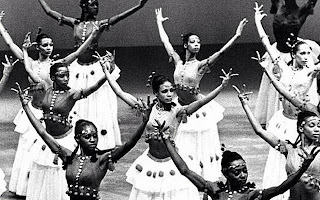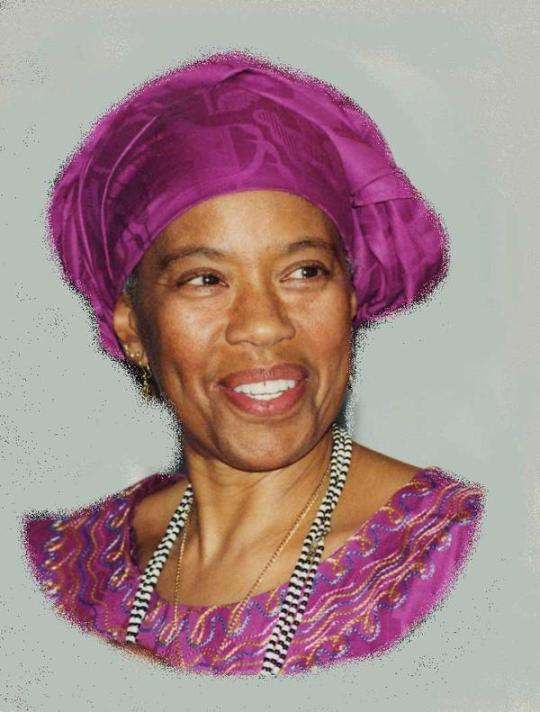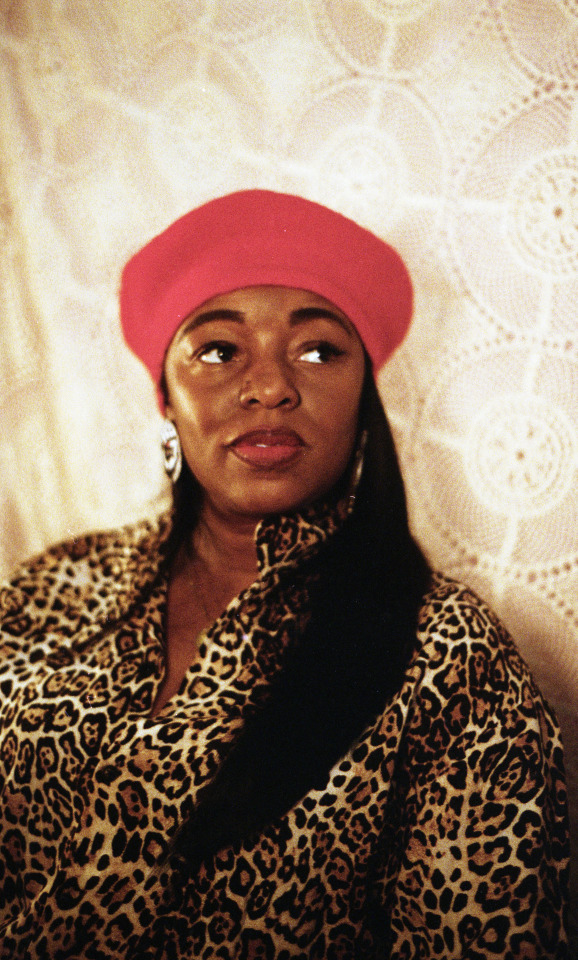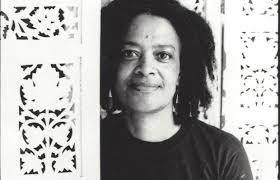This archival site covers three thematic elements within Ms. Christmas's life 1) Deconstruction and rebuilding of the art curation 2)Deconstruction and rebuilding of spaces 3)Deconstruction and rebuilding of self
Don't wanna be here? Send us removal request.
Text
Deconstruction & Rebuilding - Conclusion

Photography by Kaori Taylor, 2024, @Johns Hopkins University
Through this oral history on Ms. Christmas, we gain a understanding of her approach to deconstruction, reconstruction, and radical change-making within the realm of art and cultural work. Ms. Christmas's work embodies a commitment to amplifying the voices and experiences of Black women artists, challenging Eurocentric norms in art spaces, and reclaiming spaces traditionally dominated by white narratives.
In her curation for "we make do // wit wat we got," Ms. Christmas emphasizes the importance of knowing and forming connections with the artists, rather than just recognizing them for their artwork alone. Her process is deeply personal and relational, rooted in the fluidity of choreography and the resilience embodied in the pedagogy of making do with what one has. Through her own artistic contributions, such as her piece honoring her mother and matriarchs, she highlights the power of Black resilience and creativity in the face of adversity.
Ms. Christmas's spiritual grounding serves as a guiding force in her journey of deconstruction and rebuilding. Drawing inspiration from African spirituality and the wisdom of elders like Mama Kibibi and Dr. Marimba Ani, she navigates societal chaos and uncertainty with a steadfast faith and commitment to ancestral traditions. Prayer, connection with the spirits, and the recognition of privilege as the opportunity to do meaningful work all play integral roles in her approach to maintaining resilience and pushing forward.
Ms. Christmas's reflections on legacy keynotes her commitment to love, action, and disruption. Legacy, for her, is not about financial gain or material wealth but about creating spaces of love, accountability, and empowerment. She challenges the next generation to stand up, speak out, and take meaningful action, rejecting fear and complacency in favor of resilience and strength.
Ms. Christmas's oral history offers insights into the transformative power of art, spirituality, and activism in reshaping cultural narratives and fostering radical change. Her work serves as a beacon of inspiration for future generations of artists and activists, urging them to embrace disruption, resilience, and love as guiding principles in their own endeavors.
0 notes
Text

Dance Theater Harlem, Dougla by choreographer Geoffrey Holder, 1974
Living in Truth
So how does spirit-guided action and Respect-prioritization culminate into one person?
With boundaries,
with change-making,
with a journey of many twists and turns,
with a visionary & creator,
and an entirely unique individual.
"I don't want to be in a space where, you know how you sit, like, 'Why am I here? Why am I doing this?' I will walk away from something in a minute. So I think that, and that's my path, i’m not saying that that has been their [the elders] path. But I think that they have given me enough tools for me to create my own framework on how I want to move myself forward." (18:16-18:33) -Ms. Sharayna Ashanti Christmas
0 notes
Text

Dr. Marimba Ani
"Tough" Love & Disciplined Care
Ms. Christmas values the ways of the ancestors and elders, and with this comes the importance of Respect. In addition to paying reverence to the change-makers of the past, Ms. Christmas also emphasizes the need to honor their ways, experience, and preferences through acts that actually show this respect. Some of these practices include:
acquainting yourself with names and their spellings
avoiding showing up empty handed or late
leaving room to recognize experiences and opinions that may not align with your own
familiarizing yourself with the backgrounds and preferences of
those you are in community with, especially elders.
"She [Dr. Marimba Ani] talks about being a warrior, okay. What I love about Dr. Marimba Ani and people like Mama Kibibi, they are living, they are here with us in this realm, they are telling us constantly about ways to show up, right, and I listen to that. (14:32-14:49) I think that women like Mama Kibibi, Mama Joyce Scott, who has an exhibition at the BMA, just for reference, women like Maria Broom, Mama Kay and Mama Rashida from WombWork, like I spent a lot of time with elders, so I'm looking at these elders who are constantly pushing through, and I'm going to sit here and bitch and complain? No." (14:57-15:16)
-Ms. Sharayna Ashanti Christmas
0 notes
Text

Sharayna Christmas, 1992, Harlem, NY
"I always also, quote this scripture, you know, 'walk by faith and not by sight" (13:44-13:50)
-Ms. Sharayna Ashanti Christmas
0 notes
Text

Mama Kibibi Ajanku
Mama Kibibi
Ms. Christmas has been outspoken about her love and reverence for Mama Kibibi, and about the value and knowledge gained from her mentorship. From practices of care, to fostering creativity, paying respect to ancestors or elders, to creatively weaving traditions into art, Mama Kibibi passes down invaluable knowledge which Ms. Christmas infuses into today's Black youth.
Mama Kibibi Ajanku is an artist, curator, teacher, and innovator
"Through the melding of ancient practices and Afro-futurism, Kibibi creates new ways for people to connect with the African Diaspora and themselves."
----------------------------------------------------------------------
"I think when Mama Kibibi talks about moving out of the way to allow spirit to take over, it is a very uncomfortable thing, and I can't say that I achieved that immediately from spending time with them. I think that in stepping into the unknown, that is allowing, spirit to take over." (15:40-15:55) -Ms. Sharayna Ashanti Christmas
1 note
·
View note
Text

Portrait of Sharayna Christmas by Monica Ikewgu, 2020
Ms. Christmas pays homage to and thanks the ancestors before embarking on any new endeavor, often by offering libation and an acknowledgment of those that have come before and paved the way for our work with their sacrifices. This moment of reflection connects Ms. Christmas and those around her to the ancestors and the past, while also providing context and motivation for continuing to build towards goals, and strengthening the spirit.
----------------------------------------------------------------------
"There's no work without faith, and there's no faith without work, you know? So it's like you gotta put in the work, right, and they have set the examples." (16:20-16:30) "I think that, you know, praying and knowing that God will see you through, God will bring you through, like praying to the ancestors. I make offerings, you know, people got to do whatever's best for them. But, let me tell you something, when you see how fucked up this life is, okay? And how crazy it is, when you don't have spirit, that’s not an African way. Right. And so, Doctor Marimba Ani always talks about like, making sure that you are living in the true African way. For people being in America, for Black folks being in America, we have been completely ripped from that and stretched from that. Right? We have been we have been abused in a lot of ways. Right? We have been indoctrinated with one particular religion, which is Christianity. Right. And with Doctor Marimba Ani and what Black people have to understand is that we need all of that to keep going. We need everything" (16:33-17:21)
-Ms. Sharayna Ashanti Christmas
0 notes
Text
Connection to Spirit

Photography by Kaori Taylor, 2024, @Johns Hopkins University
Ms. Christmas is led by spirit. She evades boundaries and preconceptions by being a visionary that is not led by sight. There is no reason to contort yourself to fit other's molds when you're focused on and guided by feeding what lights up your soul. Ms. Christmas exemplifies taking initiative to fulfill your journey and actualize your ideas.
Her persistence is not without struggle though, and it is this ability to conjure up spirit through adversity that inspired my questioning. How does she maintain her strong connection to spirit? How can you strengthen your spirit throughout chaos?
0 notes
Text
Intimacy & Disruption
Many of the Black cultural workers we have examined over the course of the semester have really emphasized disruption. Carrie Mae Weems did this by addressing blackness in her work, but also placing an emphasis on gender and power. She specifically challenged beauty norms, and made the preceptor of the photography/art piece rethink the role that they place in the making of stereotypes and racism. She uses black people as subjects in her work and contrasts them with White people. This is an act of disruption because she constantly challenges the status quo and does so in a way that uplifts Black bodies, souls, and family.
These discussion points contribute to the theme of disruption, deconstruction, and rebuilding because Ms. Sharayna Christmas’ artistic ideas, spaces, and self are distinct from any other artist we have studied because of the radical empathy and care practices she endures, the way she forms her connections with other Black artists in Baltimore, and how she speaks about her lifelong legacy. Building onto this, Ms. Sharayna has an outlook on life that says “you know what? I’m going to continue to build. I’m going to look beyond that. I’m going to still invoke the act of love. The will to love which derives from concepts, form ideology, from bell hooks.” This interpretation is disruptive because it pushes past the people that are attempting to limit one’s mindset and work. She could care less about what other people think, or the Eurocentric ideology that is still propelled onto society today, and that is what makes her cultural work different. It reclaims and restores blackness.
0 notes
Text




bell hooks via NPR. Faith Ringgold via The New York Times. Carrie Mae Weems via International Photography Hall of Fame and Museum. Photo of Sharon L. Christmas, 1996.
Bell Hooks, Faith Ringgold, Carrie Mae Weems, and Sharon L. Christmas
These are Black woman cultural workers that Ms. Sharayna has looked up to and abided and evolved some of their practices and ideologies. Her mother, Ms. Sharon L. Christmas, played a large role in showing her Black culture, arts, and movements by guiding her to marches in Harlem. Ms. Sharayna acclaims Bell Hooks, Carrie Mae Weems, and Faith Ringgold, as these women disrupt the white, heterosexual, male-dominant society. Leaving an enduring impact as they do, is Ms. Sharayna's legacy.
hooks, bell. Art on My Mind: Visual Politics. PENGUIN BOOKS, 2024. Carrie Mae Weems & bell hooks
"CMW: It is working class-based; I think that reality shapes the pictures -- the way that the images are constructed... How do you make a blues piece? What does that look like? And because of the emotional response you're talking about, that emotional sensibility is embedded in the work" (hooks 89).
"bh: I think your work is counter-hegemonic in that it disturbs- it challenges and contests conventional perception...Thinking of the work as being about contestation, however, invites any viewer to work with a particular image and place themselves in relationship to the image" (hooks 77).
Kirkman, Rebekah. “Always Becoming, Never Being: An Interview with Sharayna Ashanti Christmas.” BmoreArt, 29 Oct. 2020
Ms. Sharayna: "People don't know all the work that I do cause I don't like to put myself out there in that way, but I'm starting to now... The relationship with myself in regards to my artistry is something that I've kept kind of hidden since I was a kid" (Kirkman).
“ I just want my son to know that that he is loved. And I think that that also bleeds over into how I care for the next generation, how I care for my people. Like that's what I want to be known for, is how I cared for folks, how I helped folks. I want them to to be able to look at me and say, okay, Miss Christmas or during the Christmas made it, you know, creating an example for me, you know, similar to God rest his soul, Faith Ringgold, who I taught you guys about, you know, who we just passed, on Saturday. You know, she was someone that, you know, was constantly denied constantly, I mean." - Ms. Sharayna Ashanti Christmas (8:50-9:24)
"The will to love, you know, which is you know, derive from concepts, you know, from ideology, from bell hooks, you know, and all about love and all of her books. Right?"- Ms. Christmas (9:51-10:00)
0 notes
Text

Photography by Timothy Christmas, 2009, @Theater Project Baltimore
Radical ideology:
Capitalism is embedded in society, but Ms. Sharayna Christmas does not follow that ideology in her practices- she disrupts. In parenting and her cultural work, it is all about being resourceful and doing what can with what you have, and matching words with effort.
“Yeah. Legacy for me is just really about, like, love and action. You know, it's it's it's always the unlearning of poor practice or parenting practices. When I think about me, raising my son, you know, because the thing about it is, as a black woman, you know, like, like, back to we make do with what we got.You know, I, I have I have persevered and and and broke down and burned down and built back up so many things."(8:04-8:26) "This work is not rooted in capitalism, in the way that I pursue it"- Ms. Christmas
0 notes
Text

Photography by Tobechi, 2005, Rayn Fall Dance Studio @Eubie Blake Center
Paving pathways
Ms. Christmas has set an example and provided a platform and resources for youth. She has expressed that the best we can do, is to do our best and to be brave. For one to step out of their comfort zone, to assert action and expression of opinion is to prosper.

Photography by Ms. Sharayna Ashanti Christmas, 2012, Creative Alliance, Rayn Fall Dance Studio.
Ancestors & the Future Generations
Ms. Christmas stands up and immerses herself in her work proudly. The next generations should do the same. Our ancestors have provided the grounds that we are on, yet we are not using them to our full potential.
"For other people, you know, I just hope they can see that I've created a very attainable way to do this, to do these things. And I hope that they follow in my footsteps in some kind of way and don't and are not, you know, I want my son to not be fearful. I feel like your generation is scared of a lot of things. Like y'all scared to speak up? Yes, we got with them. Yeah. I don't put it with action. Y'all make a lot of excuses. Like, that's not like when I get accolades and like, oh, I don't want to accept this compliment. If that. Like, I need to really show you standing on our shoulders, I shoulders the strong and you sitting over here, we need no like so I want my son like I constantly telling him to stand up to not be, you know, on those types of things."- Ms. Sharayna Christmas (11:12-11:49)
0 notes
Text

Photo taken on phone, 2015, Muse 360, @Eubie Blake Center
Ms. Sharayna's Legacy
Legacy derives from love, community, respect, authenticity, boldness, and leaving a long-lasting impact.
“It's like, you know, really making sure that, my legacy evokes that, like, it's like Miss Christmas, you know, Sharayna Christmas was, you know, a woman who provided who created a space for love, who held people accountable. Right? Like who disrupted. I don't want to be seen as meek and mild. I don't think that would be it."- Ms. Sharayna Ashanti Christmas (10:02-10:18)
0 notes
Text
Deconstruction and Rebuilding of Spaces

Photography by Kaori Taylor, 2024, @Johns Hopkins University
"I have persevered and and and broke down and burned down and built back up so many things." -Ms. Christmas (8:25-8:32)
Deconstructing and Rebuilding of personal spaces explores Ms. Sharayna’s interactions within the Black Arts community, her familial relationships, honoring her ancestors, inspiration from Black women cultural workers, and the future that lies in the present and coming generations. Ms. Sharayna values these spaces as the people within and connections she holds to each are intimate and cherished close to her heart and soul.
0 notes
Text


Toni Cade Bambara & June Jordan
Toni Cade Bambara and June Jordan were influential writers and activists who played significant roles in creating space for Black individuals within predominantly white spaces, much like Ms. Sharayna Christmas.
Toni Cade Bambara, best known for her novel "The Salt Eaters" and her short story collection "Gorilla, My Love," was deeply committed to representing the lives and experiences of Black people, particularly Black women, in her work. She often explored themes of race, gender, class, and identity, offering portrayals that challenged stereotypes and celebrated the diversity of Black experiences. Through her writing, Bambara gave space for Black voices in the literary world, asserting the importance of their stories. In her 1982 interview with Kay Bonetti, Toni Cade Bambara says that, "As a cultural worker who belongs to an oppressed people my job is to make revolution irresistible. One of the ways I attempt to do that is by celebrating those victories within the black community."
June Jordan, a prolific poet, essayist, and activist, was similarly dedicated to advocating for social justice and amplifying marginalized voices. Her poetry often addressed issues of racism, sexism, and oppression, while also celebrating the resilience and beauty of Black culture. Jordan was a powerful advocate for intersectionality, recognizing the interconnectedness of various forms of oppression and the importance of solidarity across different marginalized groups. Through her writing and activism, Jordan helped to create spaces where Black individuals could assert their identities and demand recognition and equality. During her career, June Jordan also taught at several colleges such as CUNY, Sarah Lawrence College, Yale University, SUNY Stony Brook, and University of California-Berkeley. Within her offered classes and student outreach, Jordan disrupted the status quo within these white institutions and swayed many student towards the path of activism.
Both Bambara and Jordan understood the importance of representation and self-expression in challenging systems of oppression and creating spaces where Black individuals could thrive. Through their literary contributions and their activism, they paved the way for future generations of Black writers, artists, and activists to assert their voices and claim their rightful place in predominantly white spaces.
9 notes
·
View notes
Text


Ms. Christmas in Adulthood by Phillip Muriel, 2023 Ms. Christmas in Childhood Headshot 1992, Harlem NY
"I was dreaming up spaces because this is all I had. And so in transit and going over to the exhibition,“we make do // wit wat we got” is just something that I always thought about, that I always think about. And it's nothing wrong with it. It's nothing wrong with making do with what you got. You make it beautiful." - Ms. Sharayna Ashanti Christmas (5:17 - 5:29)
0 notes
Text

Ms. Christmas and Abdu Ali for "We Did That" Film. Photo by Kyle Pompey, 2022
"The way that I curate is kind of the way that I choreograph. Everything has to be fluid. When you're moving and you're creating as a fluid artist or as a person -- you’re just creating a life for yourself. There's really not a lot of boundaries that you're going to be scared of, right? I'm always willing to disrupt. I'm a visionary and not everybody is a visionary. I'm not saying that lightly. Like, I know that I'm a visionary because of the things I'm born out of. Just dreaming them up. I can see it like, And so when it's not that I know how to always redirect and then kind of come back." - Ms. Sharayna Ashanti Christmas (3:02 - 3:36)
0 notes
Text

Photo by Kirby Griffin, 2018
"The idea 'we make do with what we got' is literally pedagogy that black women have created without knowing it." - Ms. Sharayna Ashanti Christmas (4:03 - 4:08)
1 note
·
View note